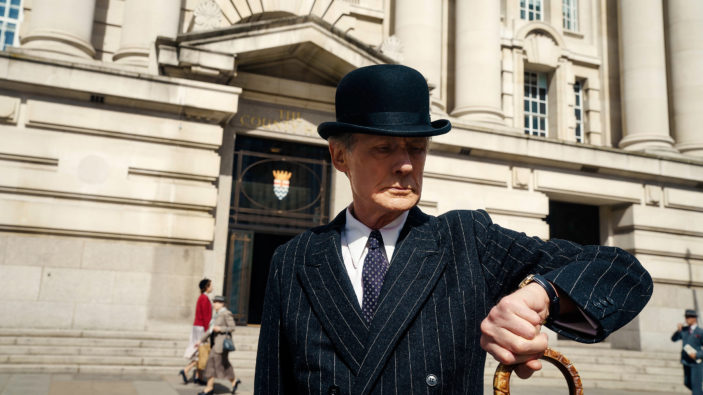
Set in 1950’s Britain, Living tells the story of Mr. Williams (Bill Nighy), a veteran civil servant who works every day in a meticulous and repetitive fashion in a government office while leading a group of colleagues to help him out. His work ethic and reputation are well known around the inner circle but the latter notice something peculiar about Williams’ demeanour.
Outside of his work life, he is a widower and he lives with his adult son. But the real shaker is that he discovers that he is diagnosed with a fatal illness. Given six to nine months to live, he decides to live the rest of his life with excitement (aided by a wonderful Tom Burke) but it does not fulfil him. But after a wonderful accompanying lunch with his spirited co-worker Margaret (Aimee Lou Wood), Williams becomes inspired to spend the rest of his days trying to bring an abandoned construction project out of limbo and onto fruition.
The prospect of remaking a renowned classic film such as Ikiru by Akira Kurosawa is a daunting one. If one were to attempt such a task, one would consider what proper reasoning would suffice for it. In the case of Living, it is a UK/Japan co-production, with producers from Japanese film studio Toho as well as Ko Kurosawa (Akira’s grandson). And it has enough interest in its standing of its storytelling (provided by acclaimed writer Kazuo Ishiguro) to provide something that is not just a carbon copy.
Thankfully, South African director Oliver Hermanus is up to the task. The film may not be up to debate in bettering the source material, but it still remains defiant and makes a very positive impression. Hermanus and Ishiguro manage to change enough of the source material to provide smart diversions in the story, making it more understated and befitting of the performances of the cast. The film dispenses of the narration of the original film and compensates it with identifiable emotions portrayed with inner life from the actors, in which involves the cast like Nighy (brilliantly taciturn and serene) and Lou Wood (enjoyably bubbly) working at their A-game.
Another storytelling choice is the inclusion of the character Mr. Wakeling, played by Alex Sharp. Essentially the audience surrogate of the film as well as a slight doppelganger of Williams himself, his role oddly enough becomes more prominent in the end of the film, showcasing the effect of Williams’ actions having a ripple effect that shows in Sharp’s understated performance. The change in setting and time period is also an inspired choice (as opposed to its then present-day time of Ikiru) as it provides a nostalgic charm to the proceedings; particularly in terms of memory.
Lastly, the production values contribute to the storytelling in ways that it becomes magical. The cinematography by Jamie Ramsay (who last worked on the stirring romantic drama Mothering Sunday) provides vivid contrasts between the colour of life and the monotony of it to striking effect. The musical score by Emilie Levienaise-Farrouch can be laid on heavily at times but it does effectively drive the drama through successfully while evoking a warm feeling of timeliness through its sweet melodies.
Living is an emotionally stirring and life-affirming drama that manages to stand on its own two feet whilst providing enough innovation to not be a cash-in remake of renowned source material. From the beautifully vivid cinematography, pleasantly melodic music, the smart storytelling decisions to stand out from its source material and fantastic performances notably from Bill Nighy and Aimee Lou Wood, Living is a winner.
FOUR STARS (OUT OF FIVE)
Living is screening as part of this year’s Sundance Film Festival, which is being presented virtually between January 20th and 30th, 2022. For more information head to the official Sundance page.
